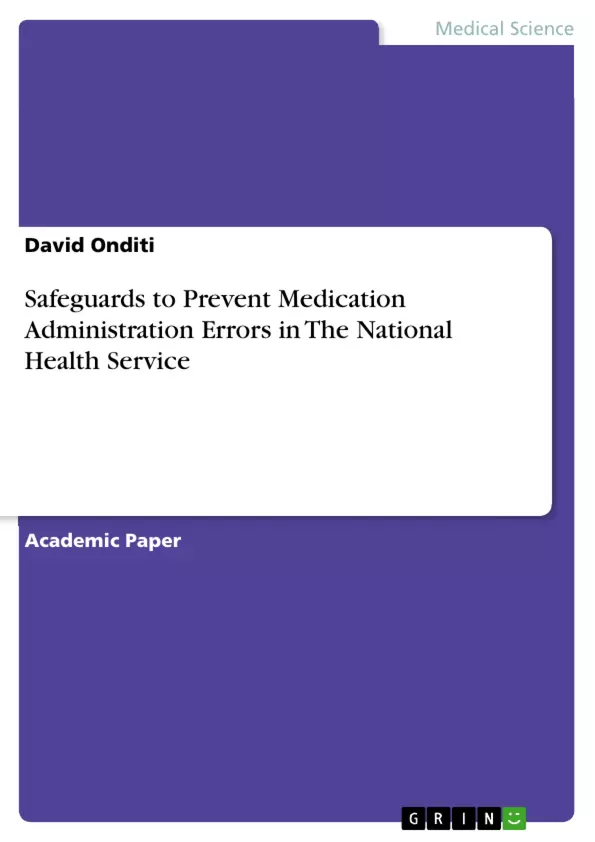This text deals with safeguards to prevent medication administration errors in general and the Automated Dispensing Cabinets (ACD) in particular. They are a decentralised medication distribution system that offers a computer controlled dispensing, storage as well as the tracking of medication at the care point in the patient care units. The author will also look at the benefits and challenges for the nurse, care delivery, and implications for patient care.
Medication errors, particularly the administration of wrong drugs is a common error type in the health care services. However, to ensure the safety of the patients, it is important to develop a system that can verify that the right drug is delivered to the correct patient; such a system is essential and basic for ensuring the improvement of care quality and the patient safety. Although errors associated with drug identity checking – cases where the health care professionals administer the wrong drug – have been put under the same category with the errors of wrong dose, such a categorisation should be reconsidered as part of quality improvement in clinical practice.
Clinical research has indicated that the implications of wrong drug errors are significantly different in terms of corrective action for the errors of wrong dose errors. Wrong drug errors entail the checking errors by the nurses and pharmacists that lead to patients nearly receiving (near misses) or receiving the wrong medication. The wrong drug errors are different from the cases of wrong dosage errors where there is a failure by the pharmacists or the nurses to ensure that the proper dosage is administered or dispensed. The wrong drug errors can lead to significant adverse effects when the psychiatrist patient receives a drug that is inappropriate for their condition. When the disorder that the patient has is not treated properly, such a patient is exposed to medication that is not only unnecessary but can also attendant adverse and side effects.
Inhaltsverzeichnis (Table of Contents)
- Selection of an area of practice that has transformed the role of the nurse
- Identification of the length of time since last practice including rationale for selected area of practice
- Impetus behind the transformation
- Benefits and challenges for the nurse, care delivery, and implications for patient care
Zielsetzung und Themenschwerpunkte (Objectives and Key Themes)
This text aims to explore the transformative impact of Automated Dispensing Cabinets (ADC) on the role of nurses, particularly in the context of psychiatric patient care. The text examines the benefits, challenges, and implications of ADC implementation for nurses, care delivery, and patient safety.
- The use of Automated Dispensing Cabinets (ADC) in psychiatric patient care.
- The prevalence and impact of medication errors in psychiatric settings.
- The benefits and challenges of ADC implementation for nurses, care delivery, and patient safety.
- The specific vulnerabilities of older adults to medication errors in psychiatric settings.
- The importance of ensuring accurate medication administration to improve patient safety and care quality.
Zusammenfassung der Kapitel (Chapter Summaries)
- Selection of an area of practice that has transformed the role of the nurse: This chapter introduces the concept of Automated Dispensing Cabinets (ADC) as a transformative force in nursing practice. It highlights the benefits of ADC, including improved medication access, timely administration, and enhanced drug control.
- Identification of the length of time since last practice including rationale for selected area of practice: This chapter focuses on the prevalence and impact of medication errors in psychiatric settings, particularly among older adults. It cites research indicating high rates of adverse drug events (ADEs) associated with psychotropic medications, highlighting the vulnerability of older adults due to factors such as polypharmacy and increased susceptibility to drug effects.
- Impetus behind the transformation: This chapter delves into the rationale for adopting ADC in psychiatric settings, emphasizing the need for a system that ensures the delivery of the right medication to the right patient. It explores the critical importance of minimizing wrong drug errors, particularly in long-term care facilities, where chronic care is provided.
Schlüsselwörter (Keywords)
This text focuses on the key concepts of Automated Dispensing Cabinets (ADC), medication errors, psychotropic medications, patient safety, older adults, and psychiatric care. It explores the impact of ADC implementation on the role of nurses, care delivery, and patient outcomes in psychiatric settings.
- Arbeit zitieren
- David Onditi (Autor:in), 2019, Safeguards to Prevent Medication Administration Errors in The National Health Service, München, GRIN Verlag, https://www.grin.com/document/504229



